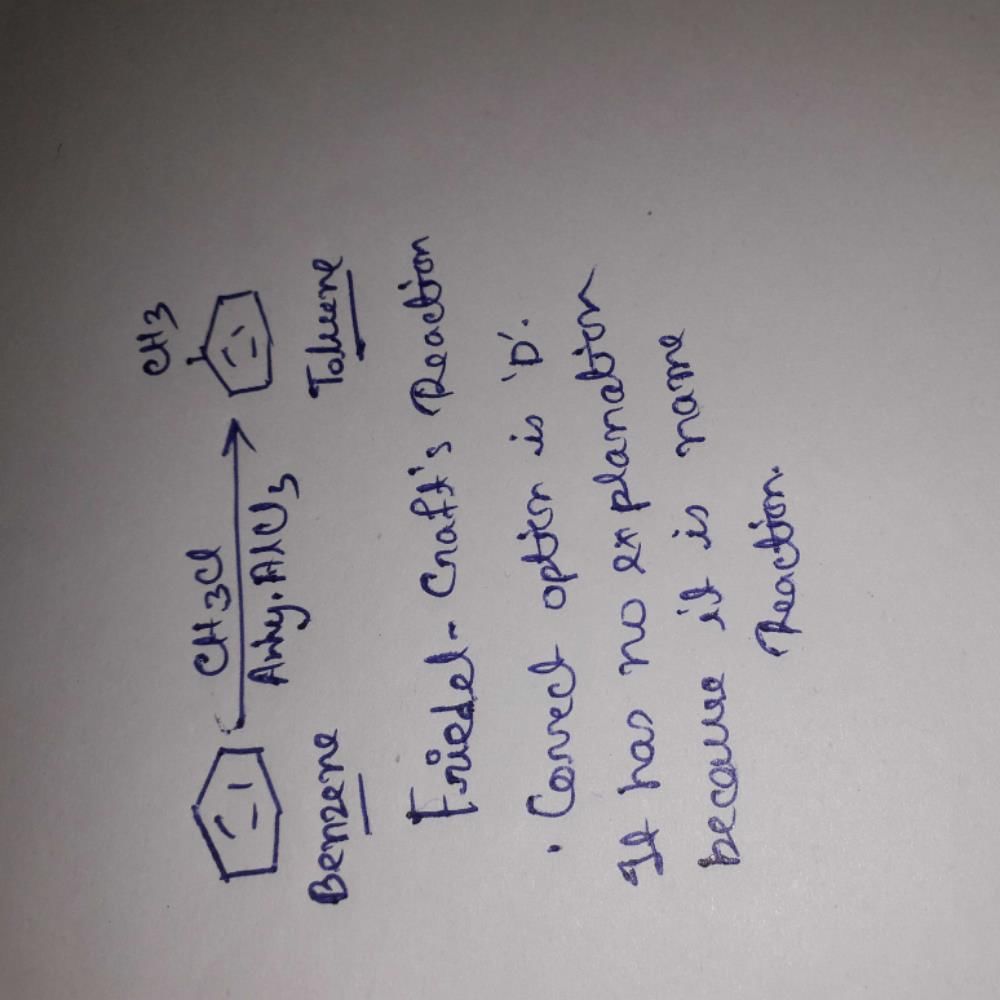JEE Exam > JEE Questions > Friedel-Craft’s reaction using MeCl and...
Start Learning for Free
Friedel-Craft’s reaction using MeCl and anhydrous AlCl3 will take place most efficiently with
- a)Benzene
- b)Nitrobenzene
- c)Acetophenone
- d)Toluene
Correct answer is option 'D'. Can you explain this answer?
Most Upvoted Answer
Friedel-Craft’s reaction using MeCl and anhydrous AlCl3 will tak...

Free Test
FREE
| Start Free Test |
Community Answer
Friedel-Craft’s reaction using MeCl and anhydrous AlCl3 will tak...
Explanation:
Friedel-Craft's acylation is a type of electrophilic aromatic substitution reaction in which an acyl group is introduced onto an aromatic ring. In this reaction, anhydrous aluminum chloride (AlCl3) acts as a Lewis acid catalyst, facilitating the formation of the acylium ion, which then reacts with the aromatic compound.
Efficiency of Friedel-Craft's reaction:
The efficiency of the Friedel-Craft's reaction using MeCl (methyl chloride) and anhydrous AlCl3 depends on the reactivity of the aromatic compound. Toluene is more reactive towards Friedel-Craft's acylation compared to benzene, nitrobenzene, or acetophenone due to its higher electron density.
Reason for choosing toluene:
- Toluene has a methyl group which is an activating group, increasing the electron density on the aromatic ring.
- The increased electron density makes toluene more susceptible to electrophilic attack, leading to a more efficient Friedel-Craft's acylation reaction.
- Benzene, nitrobenzene, and acetophenone are less reactive due to the presence of deactivating groups or lack of activating groups.
Therefore, the Friedel-Craft's reaction using MeCl and anhydrous AlCl3 will take place most efficiently with toluene among the given options.

|
Explore Courses for JEE exam
|

|
Question Description
Friedel-Craft’s reaction using MeCl and anhydrous AlCl3 will take place most efficiently witha)Benzeneb)Nitrobenzenec)Acetophenoned)TolueneCorrect answer is option 'D'. Can you explain this answer? for JEE 2025 is part of JEE preparation. The Question and answers have been prepared according to the JEE exam syllabus. Information about Friedel-Craft’s reaction using MeCl and anhydrous AlCl3 will take place most efficiently witha)Benzeneb)Nitrobenzenec)Acetophenoned)TolueneCorrect answer is option 'D'. Can you explain this answer? covers all topics & solutions for JEE 2025 Exam. Find important definitions, questions, meanings, examples, exercises and tests below for Friedel-Craft’s reaction using MeCl and anhydrous AlCl3 will take place most efficiently witha)Benzeneb)Nitrobenzenec)Acetophenoned)TolueneCorrect answer is option 'D'. Can you explain this answer?.
Friedel-Craft’s reaction using MeCl and anhydrous AlCl3 will take place most efficiently witha)Benzeneb)Nitrobenzenec)Acetophenoned)TolueneCorrect answer is option 'D'. Can you explain this answer? for JEE 2025 is part of JEE preparation. The Question and answers have been prepared according to the JEE exam syllabus. Information about Friedel-Craft’s reaction using MeCl and anhydrous AlCl3 will take place most efficiently witha)Benzeneb)Nitrobenzenec)Acetophenoned)TolueneCorrect answer is option 'D'. Can you explain this answer? covers all topics & solutions for JEE 2025 Exam. Find important definitions, questions, meanings, examples, exercises and tests below for Friedel-Craft’s reaction using MeCl and anhydrous AlCl3 will take place most efficiently witha)Benzeneb)Nitrobenzenec)Acetophenoned)TolueneCorrect answer is option 'D'. Can you explain this answer?.
Solutions for Friedel-Craft’s reaction using MeCl and anhydrous AlCl3 will take place most efficiently witha)Benzeneb)Nitrobenzenec)Acetophenoned)TolueneCorrect answer is option 'D'. Can you explain this answer? in English & in Hindi are available as part of our courses for JEE.
Download more important topics, notes, lectures and mock test series for JEE Exam by signing up for free.
Here you can find the meaning of Friedel-Craft’s reaction using MeCl and anhydrous AlCl3 will take place most efficiently witha)Benzeneb)Nitrobenzenec)Acetophenoned)TolueneCorrect answer is option 'D'. Can you explain this answer? defined & explained in the simplest way possible. Besides giving the explanation of
Friedel-Craft’s reaction using MeCl and anhydrous AlCl3 will take place most efficiently witha)Benzeneb)Nitrobenzenec)Acetophenoned)TolueneCorrect answer is option 'D'. Can you explain this answer?, a detailed solution for Friedel-Craft’s reaction using MeCl and anhydrous AlCl3 will take place most efficiently witha)Benzeneb)Nitrobenzenec)Acetophenoned)TolueneCorrect answer is option 'D'. Can you explain this answer? has been provided alongside types of Friedel-Craft’s reaction using MeCl and anhydrous AlCl3 will take place most efficiently witha)Benzeneb)Nitrobenzenec)Acetophenoned)TolueneCorrect answer is option 'D'. Can you explain this answer? theory, EduRev gives you an
ample number of questions to practice Friedel-Craft’s reaction using MeCl and anhydrous AlCl3 will take place most efficiently witha)Benzeneb)Nitrobenzenec)Acetophenoned)TolueneCorrect answer is option 'D'. Can you explain this answer? tests, examples and also practice JEE tests.

|
Explore Courses for JEE exam
|

|
Signup for Free!
Signup to see your scores go up within 7 days! Learn & Practice with 1000+ FREE Notes, Videos & Tests.


















